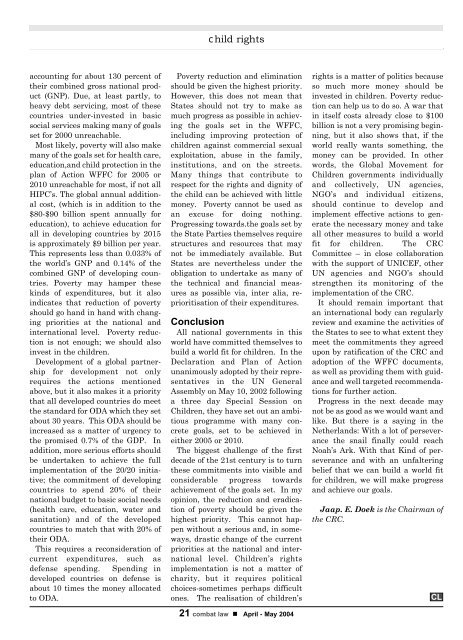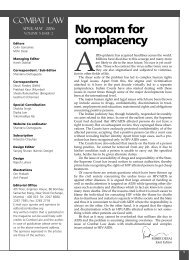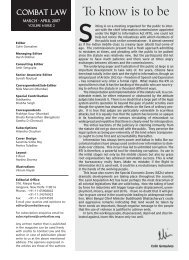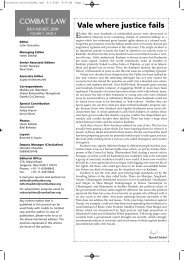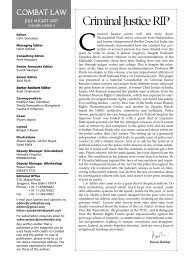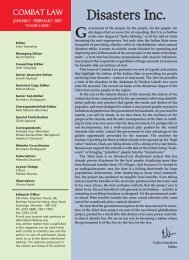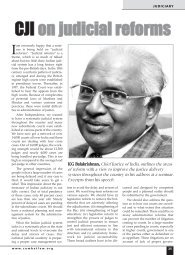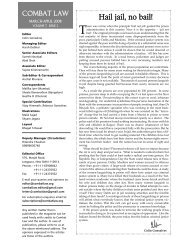PDF, 1.1MB - Combat Law
PDF, 1.1MB - Combat Law
PDF, 1.1MB - Combat Law
Create successful ePaper yourself
Turn your PDF publications into a flip-book with our unique Google optimized e-Paper software.
child rightsaccounting for about 130 percent oftheir combined gross national product(GNP). Due, at least partly, toheavy debt servicing, most of thesecountries under-invested in basicsocial services making many of goalsset for 2000 unreachable.Most likely, poverty will also makemany of the goals set for health care,education,and child protection in theplan of Action WFFC for 2005 or2010 unreachable for most, if not allHIPC’s. The global annual additionalcost, (which is in addition to the$80-$90 billion spent annually foreducation), to achieve education forall in developing countries by 2015is approximately $9 billion per year.This represents less than 0.033% ofthe world’s GNP and 0.14% of thecombined GNP of developing countries.Poverty may hamper thesekinds of expenditures, but it alsoindicates that reduction of povertyshould go hand in hand with changingpriorities at the national andinternational level. Poverty reductionis not enough; we should alsoinvest in the children.Development of a global partnershipfor development not onlyrequires the actions mentionedabove, but it also makes it a prioritythat all developed countries do meetthe standard for ODA which they setabout 30 years. This ODA should beincreased as a matter of urgency tothe promised 0.7% of the GDP. Inaddition, more serious efforts shouldbe undertaken to achieve the fullimplementation of the 20/20 initiative;the commitment of developingcountries to spend 20% of theirnational budget to basic social needs(health care, education, water andsanitation) and of the developedcountries to match that with 20% oftheir ODA.This requires a reconsideration ofcurrent expenditures, such asdefense spending. Spending indeveloped countries on defense isabout 10 times the money allocatedto ODA.Poverty reduction and eliminationshould be given the highest priority.However, this does not mean thatStates should not try to make asmuch progress as possible in achievingthe goals set in the WFFC,including improving protection ofchildren against commercial sexualexploitation, abuse in the family,institutions, and on the streets.Many things that contribute torespect for the rights and dignity ofthe child can be achieved with littlemoney. Poverty cannot be used asan excuse for doing nothing.Progressing towards.the goals set bythe State Parties themselves requirestructures and resources that maynot be immediately available. ButStates are nevertheless under theobligation to undertake as many ofthe technical and financial measuresas possible via, inter alia, reprioritisationof their expenditures.ConclusionAll national governments in thisworld have committed themselves tobuild a world fit for children. In theDeclaration and Plan of Actionunanimously adopted by their representativesin the UN GeneralAssembly on May 10, 2002 followinga three day Special Session onChildren, they have set out an ambitiousprogramme with many concretegoals, set to be achieved ineither 2005 or 2010.The biggest challenge of the firstdecade of the 21st century is to turnthese commitments into visible andconsiderable progress towardsachievement of the goals set. In myopinion, the reduction and eradicationof poverty should be given thehighest priority. This cannot happenwithout a serious and, in someways,drastic change of the currentpriorities at the national and internationallevel. Children’s rightsimplementation is not a matter ofcharity, but it requires politicalchoices-sometimes perhaps difficultones. The realisation of children’s21 combat law • April - May 2004rights is a matter of politics becauseso much more money should beinvested in children. Poverty reductioncan help us to do so. A war thatin itself costs already close to $100billion is not a very promising beginning,but it also shows that, if theworld really wants something, themoney can be provided. In otherwords, the Global Movement forChildren governments individuallyand collectively, UN agencies,NGO’s and individual citizens,should continue to develop andimplement effective actions to generatethe necessary money and takeall other measures to build a worldfit for children. The CRCCommittee – in close collaborationwith the support of UNICEF, otherUN agencies and NGO’s shouldstrengthen its monitoring of theimplementation of the CRC.It should remain important thatan international body can regularlyreview and examine the activities ofthe States to see to what extent theymeet the commitments they agreedupon by ratification of the CRC andadoption of the WFFC documents,as well as providing them with guidanceand well targeted recommendationsfor further action.Progress in the next decade maynot be as good as we would want andlike. But there is a saying in theNetherlands: With a lot of perseverancethe snail finally could reachNoah’s Ark. With that Kind of perseveranceand with an unfalteringbelief that we can build a world fitfor children, we will make progressand achieve our goals.Jaap. E. Doek is the Chairman ofthe CRC.CL


